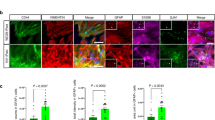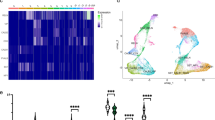Abstract
Glioneuronal lesions are frequently observed in biopsy specimens obtained from patients with pharmacoresistant epilepsies, comprising focal cortical dysplasias (FCD) and gangliogliomas. Recent findings point to the phosphoinositide 3-kinase (PI3K) pathway and tuberin/hamartin signaling cascade as being compromised in these lesions. Ezrin, radixin and moesin (ERM-/band-4.1 proteins) genes represent downstream effectors of the PI3K pathway, are involved in cytoskeleton-membrane interference, cell growth, migration and differentiation, and harbor tumor suppressor motifs. Accumulation of band-4.1 proteins has been identified in cortical tubers of tuberous sclerosis patients, which share neuropathological similarities with FCD and gangliogliomas. Here, we have studied the immunohistochemical distribution pattern of ERMs, as well as allelic variants, occurring in gangliogliomas (n=20) and FCDs (FCDIIa, n=7; FCDIIb, n=37). Aberrant accumulation of ERMs was observed in dysplastic neurons of FCDs and gangliogliomas as well as in balloon cells. Adjacent brain tissue without structural abnormalities was used as control and showed only faint neuropil staining. Mutational screening revealed silent polymorphisms in the ezrin gene in two individuals suffering from FCDIIb. A transition from G to A in radixin exon 2 resulted in an exchange of valine by isoleucine at codon 50 in an additional FCDIIb specimen. Such sequence alterations were not found in controls. The present data suggest accumulation of ERM expression in dysplastic cellular components but do not favor mutational events of ERM in the pathogenesis of FCDs or gangliogliomas. Aberrant expression of ERMs is, however, compatible with compromised PI3K-pathway signaling in glioneuronal lesions characterized by abnormal cellular differentiation and aberrant network formation.



Similar content being viewed by others
References
Andreoli C, Martin M, Le Borgne R, Reggio H, Mangeat P (1994) Ezrin has properties to self-associate at the plasma membrane. J Cell Sci 107:2509–2521
Astrinidis A, Cash TP, Hunter DS, Walker CL, Chernoff J, Henske EP (2002) Tuberin, the tuberous sclerosis complex 2 tumor suppressor gene product, regulates Rho activation, cell adhesion and migration. Oncogene 21:8470–8476
Baybis M, Yu J, Lee A, Golden JA, Weiner H, McKhann G, 2nd, Aronica E, Crino PB (2004) mTOR cascade activation distinguishes tubers from focal cortical dysplasia. Ann Neurol 56:478–487
Becker AJ, Löbach M, Klein H, Normann S, Nöthen MM, Deimling A von, Mizuguchi M, Elger CE, Schramm J, Wiestler OD, Blümcke I (2001) Mutational analysis of TSC1 and TSC2 genes in gangliogliomas. Neuropathol Appl Neurobiol 27:105–114
Becker AJ, Urbach H, Scheffler B, Baden T, Normann S, Lahl R, Pannek HW, Tuxhorn I, Elger CE, Schramm J, Wiestler OD, Blümcke I (2002) Focal cortical dysplasia of Taylor’s balloon cell type: mutational analysis of the TSC1 gene indicates a pathogenic relationship to tuberous sclerosis. Ann Neurol 52:29–37
Bentivoglio M, Tassi L, Pech E, Costa C, Fabene PF, Spreafico R (2003) Cortical development and focal cortical dysplasia. Epileptic Disord 5:27–34
Blümcke I, Wiestler OD (2002) Gangliogliomas: an intriguing tumor entity associated with focal epilepsies. J Neuropathol Exp Neurol 61:575–584
Blümcke I, Giencke K, Wardelmann E, Beyenburg S, Kral T, Sarioglu N, Pietsch T, Wolf HK, Schramm J, Elger CE, Wiestler OD (1999) The CD34 epitope is expressed in neoplastic and malformative lesions associated with chronic, focal epilepsies. Acta Neuropathol 97:481–490
Crino PB (2004) Malformations of cortical development: molecular pathogenesis and experimental strategies. Adv Exp Med Biol 548:175–191
Dabora SL, Jozwiak S, Franz DN, Roberts PS, Nieto A, Chung J, Choy YS, Reeve MP, Thiele E, Egelhoff JC, Kasprzyk-Obara J, Domanska-Pakiela D, Kwiatkowski DJ (2001) Mutational analysis in a cohort of 224 tuberous sclerosis patients indicates increased severity of TSC2, compared with TSC1, disease in multiple organs. Am J Hum Genet 68:64–80
Daumas-Duport C, Scheithauer BW, Chodkiewicz JP, Laws ER Jr, Vedrenne C (1988) Dysembryoplastic neuroepithelial tumor: a surgically curable tumor of young patients with intractable partial seizures. Report of thirty-nine cases. Neurosurgery 23:545–556
Derouiche A, Frotscher M (2001) Peripheral astrocyte processes: monitoring by selective immunostaining for the actin-binding ERM proteins. Glia 36:330–341
Fassunke J, Majores M, Ullmann C, Elger CE, Schramm J, Wiestler OD, Becker AJ (2004) In situ-RT and immunolaser microdissection for mRNA analysis of individual cells isolated from epilepsy-associated glioneuronal tumors. Lab Invest 84:1520–1525
Fauser S, Becker A, Schulze-Bonhage A, Hildebrandt M, Tuxhorn I, Pannek HW, Lahl R, Schramm J, Blumcke I (2004) CD34-immunoreactive balloon cells in cortical malformations. Acta Neuropathol 108:272–278
Gary R, Bretscher A (1995) Ezrin self-association involves binding of an N-terminal domain to a normally masked C-terminal domain that includes the F-actin binding site. Mol Biol Cell 6:1061–1075
Gautreau A, Louvard D, Arpin M (2002) ERM proteins and NF2 tumor suppressor: the Yin and Yang of cortical actin organization and cell growth signaling. Curr Opin Cell Biol 14:104–109
Golden JA (2001) Cell migration and cerebral cortical development. Neuropathol Appl Neurobiol 27:22–28
Gonzalez-Agosti C, Solomon F (1996) Response of radixin to perturbations of growth cone morphology and motility in chick sympathetic neurons in vitro. Cell Motil Cytoskeleton 34:122–136
Haddad LA, Smith N, Bowser M, Niida Y, Murthy V, Gonzalez-Agosti C, Ramesh V (2002) The TSC1 tumor suppressor hamartin interacts with neurofilament-L and possibly functions as a novel integrator of the neuronal cytoskeleton. J Biol Chem 277:44180–44186
Hay N, Sonenberg N (2004) Upstream and downstream of mTOR. Genes Dev 18:1926–945
Hebsgaard SM, Korning PG, Tolstrup N, Engelbrecht J, Rouze P, Brunak S (1996) Splice site prediction in Arabidopsis thaliana pre-mRNA by combining local and global sequence information. Nucleic Acids Res 24:3439–3452
Hildebrandt M, Pieper T, Winkler P, Kolodziejczyk D, Holthausen H, Blumcke I (2005) Neuropathological spectrum of cortical dysplasia in children with severe focal epilepsies. Acta Neuropathol 110:1-11
Hoeflich KP, Ikura M (2004) Radixin: cytoskeletal adopter and signaling protein. Int J Biochem Cell Biol 36:2131–2136
Jansen FE, Notenboom RG, Nellist M, Goedbloed MA, Halley DJ, Graan PN de, Nieuwenhuizen O van (2004) Differential localization of hamartin and tuberin and increased S6 phosphorylation in a tuber. Neurology 63:1293–1295
Johnson MW, Miyata H, Vinters HV (2002) Ezrin and moesin expression within the developing human cerebrum and tuberous sclerosis-associated cortical tubers. Acta Neuropathol 104:188–196
Kleihues P, Cavenee WK (2000) Pathology and genetics of tumours of the nervous system. IARC, Lyon
Kral T, Clusmann H, Urbach J, Schramm J, Elger CE, Kurthen M, Grunwald T (2002) Preoperative evaluation for epilepsy surgery (Bonn Algorithm). Zentralbl Neurochir 63:106–110
Kwiatkowski DJ (2003) Tuberous sclerosis: from tubers to mTOR. Ann Hum Genet 67:87–96
Lamb RF, Roy C, Diefenbach TJ, Vinters HV, Johnson MW, Jay DG, Hall A (2000) The TSC1 tumour suppressor hamartin regulates cell adhesion through ERM proteins and the GTPase Rho. Nat Cell Biol 2:281–287
Majander-Nordenswan P, Sainio M, Turunen O, Jaaskelainen J, Carpen O, Kere J, Vaheri A (1998) Genomic structure of the human ezrin gene. Hum Genet 103:662–665
Majores M, Blumcke I, Urbach H, Meroni A, Hans V, Holthausen H, Elger CE, Schramm J, Galli C, Spreafico R, Wiestler OD, Becker AJ (2005) Distinct allelic variants of TSC1 and TSC2 in epilepsy-associated cortical malformations without balloon cells. J Neuropathol Exp Neurol 64:629–637
McClatchey AI (2003) Merlin and ERM proteins: unappreciated roles in cancer development? Nat Rev Cancer 3:877–883
McLendon RE, Provenzale J (2002) Glioneuronal tumors of the central nervous system. Brain Tumor Pathol 19:51–58
Miyata H, Chiang AC, Vinters HV (2004) Insulin signaling pathways in cortical dysplasia and TSC-tubers: tissue microarray analysis. Ann Neurol 56:510–519
Paglini G, Kunda P, Quiroga S, Kosik K, Caceres A (1998) Suppression of radixin and moesin alters growth cone morphology, motility, and process formation in primary cultured neurons. J Cell Biol 143:443–455
Palmini A, Najm I, Avanzini G, Babb T, Guerrini R, Foldvary-Schaefer N, Jackson G, Luders HO, Prayson R, Spreafico R, Vinters HV (2004) Terminology and classification of the cortical dysplasias. Neurology 62:2–8
Perry A, Gutmann DH, Reifenberger G (2004) Molecular pathogenesis of meningiomas. J Neurooncol 70:183–202
Sato N, Yonemura S, Obinata T, Tsukita S (1991) Radixin, a barbed end-capping actin-modulating protein, is concentrated at the cleavage furrow during cytokinesis. J Cell Biol 113:321–330
Sawin PD, Theodore N, Rekate HL (1999) Spinal cord ganglioglioma in a child with neurofibromatosis type 2. Case report and literature review. J Neurosurg Spine 90:231–233
Schütze K, Lahr G (1998) Identification of expressed genes by laser-mediated manipulation of single cells. Nat Biotechnol 16:737–742
Schwartzkroin PA, Walsh CA (2000) Cortical malformations and epilepsy. Ment Retard Dev Disabil Res Rev 6:268–280
Takeuchi K, Sato N, Kasahara H, Funayama N, Nagafuchi A, Yonemura S, Tsukita S (1994) Perturbation of cell adhesion and microvilli formation by antisense oligonucleotides to ERM family members. J Cell Biol 125:1371–1384
The European Chromosome 16 Tuberous Sclerosis Consortium (1993) Identification and characterization of the tuberous sclerosis gene on chromosome 16. Cell 75:1305–1315
Tsukita S, Hieda Y (1989) A new 82-kD barbed end-capping protein (radixin) localized in the cell-to-cell adherens junction: purification and characterization. J Cell Biol 108:2369–2382
Tsukita S, Yonemura S (1999) Cortical actin organization: lessons from ERM (ezrin/radixin/moesin) proteins. J Biol Chem 274:34507–34510
Turunen O, Wahlstrom T, Vaheri A (1994) Ezrin has a COOH-terminal actin-binding site that is conserved in the ezrin protein family. J Cell Biol 126:1445–1453
Urbach H, Scheffler B, Heinrichsmeier T, Oertzen J von, Kral T, Wellmer J, Schramm J, Wiestler OD, Blümcke I (2002) Focal cortical dysplasia of Taylor’s balloon cell type: a clinicopathological entity with characteristic neuroimaging and histopathological features, and favorable postsurgical outcome. Epilepsia 43:33–40
Van Slegtenhorst M, Hoogt R de, Hermans C, Nellist M, Janssen B, Verhoef S, Lindhout D, Ouweland A van den, Halley D, Young J, et al (1997) Identification of the tuberous sclerosis gene TSC1 on chromosome 9q34. Science 277:805–808
Wilgenbus KK, Milatovich A, Francke U, Furthmayr H (1993) Molecular cloning, cDNA sequence, and chromosomal assignment of the human radixin gene and two dispersed pseudogenes. Genomics 16:199–206
Wilgenbus KK, Hsieh CL, Lankes WT, Milatovich A, Francke U, Furthmayr H (1994) Structure and localization on the X chromosome of the gene coding for the human filopodial protein moesin (MSN). Genomics 19:326–333
Wolf HK, Wellmer J, Muller MB, Wiestler OD, Hufnagel A, Pietsch T (1995) Glioneuronal malformative lesions and dysembryoplastic neuroepithelial tumors in patients with chronic pharmacoresistant epilepsies. J Neuropathol Exp Neurol 54:245–254
Yonemura S, Matsui T, Tsukita S (2002) Rho-dependent and -independent activation mechanisms of ezrin/radixin/moesin proteins: an essential role for polyphosphoinositides in vivo. J Cell Sci 115:2569–2580
Acknowledgements
Our work was supported by DFG (SFB TR3 to A.J.B., J.S., C.E.E.; Bl 421/1–1 to I.B.), BONFOR and Deutsche Krebshilfe. We especially thank Prof. Shoichiro Tsukita and colleagues for kindly providing antibodies against ERM proteins.
Author information
Authors and Affiliations
Corresponding author
Rights and permissions
About this article
Cite this article
Majores, M., Schick, V., Engels, G. et al. Mutational and immunohistochemical analysis of ezrin-, radixin-, moesin (ERM) molecules in epilepsy-associated glioneuronal lesions. Acta Neuropathol 110, 537–546 (2005). https://doi.org/10.1007/s00401-005-1088-3
Received:
Revised:
Accepted:
Published:
Issue Date:
DOI: https://doi.org/10.1007/s00401-005-1088-3




